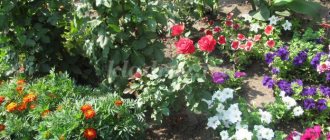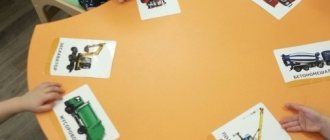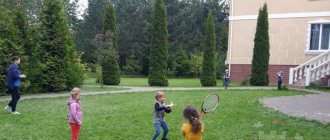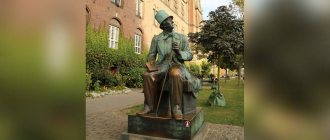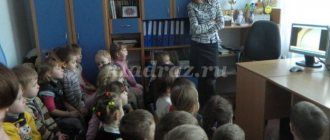Fun physical education
Physical exercise is a very useful activity, but also very boring if you do it without any imagination. Try this: “Let’s reach for the sun (stretch), collect the sun’s rays and put them on the grass (tilts), take the ray on the right and put it on the left, and now vice versa (tilt to the opposite legs).
Now let’s sit on the grass and collect the rays around us (turn left and right). The rays have gathered, now let's gather the clouds. We grab it and put it down (jump up, bend over).”
Play animals' game - let your child show how a bear, fox, bunny, cat, etc. walk.
Targeted walks around the site - 2 ml. gr. (forward planning)
Tatyana Gazizova
Targeted walks around the site - 2 ml. gr. (forward planning)
MBDOU "Kindergarten No. 2"
Targeted walks
and walks around the neighborhood for children 3-4 years old
(Perspective plan)
Completed by: Gazizova Tatyana Borisovna
teacher 1st quarter categories
Gubakha - 2011 - 2012 academic year. year
Targeted walks around the site –
are held once a week.
September
1. “Looking at the flowers in the flowerbed.”
Goal: to teach to look at plants on the site and talk about them.
Questions: Do you like flowers? What do flowers look like (like the sun, a butterfly, etc.? Are all the flowers the same color? Offer to find small ones, and then large ones. Read short poems about flowers with content accessible to children.
2. “Who lives on our site?” Examination of insects that “live” in the group’s area.
Goals: to teach children to observe, explain the purpose and function of individual items and objects.
Questions: what does an ant (butterfly, bee, grasshopper, etc.) have? What can he do? What are insects for? Reading short poems about insects with child-friendly content.
3. “Introducing children to the kindergarten garden.”
Goals: to awaken in children a sense of interest and involvement in everything growing on the site, to clarify the names of vegetables and fruits growing on the site.
Questions: what grows in our garden? What grows on a bush and what in the ground? What are your favorite vegetables and what are your favorite fruits? Reading short poems about fruits and vegetables, asking riddles with content accessible to children.
4. “What kind of trees and shrubs grow here?”
Goals: continue to teach how to look at plants on the site and talk about them, clarify the names.
Questions: do you like birch (rowan, poplar, maple, etc.? What does this or that plant look like (like a Christmas tree, teddy bear, dog, etc.? Suggest finding low and then tall plants. Reading short poems about trees and shrubs with content accessible to children.
October
1. “Examining the houses around the kindergarten.”
Goals: to teach children to observe and examine, to explain the purpose and function of individual items and objects.
Questions: what kind of houses do children see near the kindergarten? Are there similar buildings? How are they similar? What different things did you notice in the houses? In which buildings do people live and in which do they work? Do animals have homes?
2. “Observation of leaf fall.”
Goals: to teach children to observe leaf fall, to evoke joy from the phenomenon occurring in nature.
Questions: Where do the leaves fall from? When does leaf fall occur? How leaves fly (slowly, quickly, whirling, rustling, etc.). What color are the fallen leaves, which ones are there more? What do fallen leaves form on the ground (a multi-colored carpet? Is it pleasant to walk on a carpet of leaves? Why?
3. “Looking at an autumn tree.”
Goal: to teach to look at plants on the site and talk about them.
Questions: name the main parts of the tree (trunk, branches, roots). Pay attention to their height and thickness. What is the name of this tree (bush?) Clarify the knowledge of why it is called that, why we need it. How should we take care of it?
4. “Who came to visit us?”
Goals: to teach children to observe, explain the purpose and function of individual objects; teach to look at birds that have flown to the site and talk about them.
Questions: what kind of birds do you see (sparrows, pigeons, titmice, jackdaws, crows, magpies, etc.? What do birds do? Where do birds live? How do they talk (chirp? Why do birds fly? Why do birds need a beak? Can we do anything? then help the birds?
November
1. “Observation of the spruce tree.”
Goals: to consolidate children’s ideas about the external features of spruce, to continue to teach how to look at plants on the site and talk about them, to clarify the names.
Questions: what did the spruce tree have instead of leaves? What color are the spruce needles? Do they change their color? Pay attention to the height and thickness, length of the branches. Clarify knowledge about why it is called that, why we need it. How should you take care of it?
2. “Observation of freshly fallen snow.”
Goals: to teach children to observe and examine, see and notice changes in natural phenomena.
Questions: Do you like snow? What does the first snow look like? Why has the street become more beautiful and brighter?
3. “What has changed?”
Goals: to help children adapt to changed conditions on the site; activate the visual perception and attention of children, create an emotionally positive mood.
Questions: what has changed in our area? Where did the leaves, grass, flowers go? What were the trees with leaves like? (Elegant, bright, beautiful). What are trees without leaves like? (Sad, dark). Where are the insects - butterflies, ants, bugs, spiders? What happened?
4. "Observation of ice."
Goals: to teach children to observe and examine, to explain the purpose and function of individual items and objects.
Questions: When does ice appear, when is it cold or warm? What does ice look like? Is ice warm or cold? What happens to ice if you pierce it with a stick? What will happen if you take it in your palm?
December
1. “Whose trace.”
Goals: to awaken in children a sense of interest and involvement in everything that they see and notice, to teach children to observe, examine and talk.
Questions: whose trace is this? What does this trail look like? Whose footprint is bigger?
2. “What kind of snow is there?”
Goals: to teach children to observe and examine, see and notice changes in natural phenomena.
Questions: Do you like playing in the snow? What kind of snow will it be like if you pour water on it (experiment? What do snowflakes look like? How do they fly?
3. “Feeding the birds.”
Goals: continue to teach children to observe and examine birds that have flown to the site and talk about them.
Questions: Why do birds fly to our feeder? Which treat do they like best? What birds flew to our feeder? Have new birds appeared? (Name some birds).
4. “What did the trees and shrubs become like?”
Goals: continue to teach how to look at plants on the site and talk about them, clarify the names.
Questions: Do you like birch (rowan, poplar, maple, etc.? What does this or that plant look like (like a Christmas tree, a bear, a dog, etc.? Suggest finding low and then tall plants. Reading short poems about trees and shrubs with child-friendly content.
January
1. “Bird watching.”
Goals: to awaken in children a sense of interest and involvement in everything that they see and notice, to teach children to observe, examine and talk.
Questions: What birds flew to us today (children, with the help of the teacher, remember the names of the birds? Are there among the birds the bravest, the most curious, the fastest, the most fearful?
2. “How interesting it is for children to play in winter!”
Goals: to teach children to observe and examine, to explain the purpose and function of individual items and objects.
Questions: Do you like playing in the snow? How do children play and what do they do? What are they riding on, what are they doing? Pay attention to the relationships between children during the game.
3. “Observation of icicles.”
Goals: to teach children to observe and examine, see and notice changes in natural phenomena. To introduce the diversity of water conditions in the environment.
Questions: What do icicles look like? What are icicles made from? What will happen to the icicle if you take it in your hand and bring it into the group? Can I take it in my mouth, why?
February
1. “Footprints in the snow.”
Goals: to awaken in children a sense of interest and involvement in everything that they see and notice, to teach children to observe, examine and talk.
Questions: whose trace is this? What does this trail look like? Whose footprint is bigger? Guessing tracks: children's, adults, birds, animals.
2. “Observation of a blizzard, blizzard.”
Goals: to teach children to observe and examine, see and notice changes in natural phenomena, listen to the howl of the wind, watch how it carries snow, sweeps snowdrifts.
Questions: What do snowflakes look like? How do they fly? How does it snow (slowly, quickly?
3. “What kind of bird?”
Goals: continue to teach children to observe and examine birds that have flown to the site and talk about them, to develop the ability to behave calmly near them when observing.
Questions: Why do birds fly to our feeder? What birds flew to our feeder? Have new birds appeared? Offer to find a crow, observe its habits, movement, and listen to the sounds it makes. Pay attention to the typical color, size, consolidate the ability to recognize it by appearance, sounds made.
4. “We walk and don’t break bushes.”
Goals: to cultivate a caring attitude towards trees and shrubs, we continue to teach how to examine and compare trees, practice distinguishing them by trunk color and name, clarify knowledge about the structure of a tree: trunk, branches; continue to teach to see the beauty of snow-covered trees.
Questions: Do you like birch (rowan, poplar, maple, etc.? What does this or that plant look like (like a Christmas tree, a bear, a dog, etc.? Suggest that you find low and then tall plants, show where trunk, branches, roots Reading short poems about trees and shrubs with content accessible to children.
March
1. “We watch the sky.”
Goals: to awaken in children a sense of interest and involvement in everything that they see and notice, to teach children to observe, examine and talk.
Questions: What is the sky like now? Are there clouds or clouds in the sky? Offer to watch how the clouds move across the sky.
2. “Our birds.”
Goals: continue to teach children to observe and examine birds that have flown to the site and talk about them, pay attention to their differences and similarities; cultivate the ability to behave calmly around them when observing.
Questions: Why do birds fly to our feeder? What birds flew to our feeder? Have new birds appeared? Offer to find a dove and a sparrow, observe their habits, movements, and listen to the sounds they make. Pay attention to the typical color, size, consolidate the ability to recognize them by appearance, sounds made.
3. “Spring has come. Reading of A. Pleshcheev’s poem “Spring”.
Goals: continue to teach children to observe and notice changes in nature, develop the ability to listen and answer the teacher’s questions.
Questions: What time of year did the poet write the poem about? What time of year is it? What time of year is it? What happens to the snow? What birds will sing about spring? What will appear on the trees soon? What was the sun like in spring? Who loves spring? Why?
4. “Our trees and shrubs.”
Goals: continue to cultivate a caring attitude towards trees and shrubs, teach to examine and compare trees, consolidate the ability to distinguish between 2-3 trees by the color of the trunk, knowledge about the structure of a tree: trunk, branches.
Questions: Do you like birch (rowan, poplar? What does this or that plant look like (a Christmas tree, a bear, a dog, etc.? Suggest that you find low and then tall plants, show where the trunk, branches, roots are. Reading short poems about trees and shrubs with content accessible to children.
April
1. “Birds in the spring.”
Goals: continue to teach children to observe and examine birds that have flown to the site and talk about them, pay attention to their differences and similarities; cultivate the ability to behave calmly around them when observing.
Questions: what do birds build in trees? Why do birds build nests? Why are their nests located so high? Is it possible to destroy birds' nests? Pay attention to the typical color, size, consolidate the ability to recognize them by appearance, sounds made.
2. “Our trees and shrubs in spring.”
Goals: continue to cultivate a caring attitude towards trees and shrubs, teach to examine and compare trees, consolidate the ability to distinguish between 2-3 trees by the color of the trunk, knowledge about the structure of a tree: trunk, branches.
Questions: what appeared on the tree branches (buds? Why did the buds swell? What will appear on the branches when the buds open? Offer to find low and then tall plants, show where the trunk, branches, roots are. Reading short poems about trees and shrubs with child-friendly content.
3. “Observations of a drop.”
Goals: continue to teach children to observe and notice changes in nature, develop the ability to listen and answer the teacher’s questions, and lead to independent conclusions.
Questions: What time of year is it? What happens to the snow, to the icicles? Offer to watch the drops and streams. Find out why this is happening.
4. “What will spring give?”
Goals: to awaken in children a sense of interest and involvement in everything that they see and notice, to teach children to observe, examine and talk.
Observations: Search for natural material to replenish the spring piggy bank.
May
1. “Watching the sun.”
Goals: to awaken in children a sense of interest and involvement in everything that they see and notice, to teach children to observe, examine and talk. Draw your own conclusions.
Observations: Pay attention to the spring sun: bright, warm. Offer to stand facing the sun and feel its warmth. Compare temperatures in the sun and in the shade. Watch the snow melt on the site and on the molds placed in the sun.
2. "Gifts of spring."
Goal: to clarify children’s ideas about what happens in nature in the spring (with trees, the sky, the sun, animals, how the clothes of children and adults change, what entertainment awaits children in the spring.
Questions: What time of year is it? What will appear on the trees soon? What was the sun like in spring? Who loves spring? Why? What birds will sing about spring? What has changed in our area? How do children play and what do they do? What are they doing? Pay attention to the relationships between children during the game.
3. “Suns on the grass.”
Goals: to form children’s ideas about the dandelion, to introduce the first spring flower and its structure; cultivate an emotional response to the beauty of the plant.
Questions: what grows in the clearing? What color is the grass and what color are the flowers? What does a dandelion look like? What does a dandelion stand on? What kind of stem does a dandelion have: long or short, thick or thin, smooth or rough? Reading a poem about dandelion.
4. “Who lives on our site?” Examination of insects that “live” in the group’s area.
Goals: to teach children to observe, explain the purpose and function of individual items and objects.
Questions: what does an ant (butterfly, bee, grasshopper, etc.) have? What can he do? What are insects for? Reading short poems about insects with child-friendly content.
Walk around the neighborhood
is held once a month.
September: “Walk along the street adjacent to the kindergarten.”
Goals: to awaken in children a sense of interest and involvement in everything that happens around them, to introduce them to the rules of safe behavior on the street, and to begin to familiarize them with the names of the streets of their hometown.
October: “Walk through the neighborhood where the kindergarten is located.”
Goals: to awaken in children a sense of interest and involvement in everything that happens around them, continue to introduce the rules of safe behavior on the street, pay attention to objects (shops, parks, sculptures, etc., explain the purpose and function of individual items and objects .
November: "Walk to the bus station."
Goals: to awaken in children a sense of interest and involvement in everything that happens around, continue to introduce the rules of safe behavior on the street, pay attention to objects (buses, cars and trucks, explain the purpose and function of individual objects, their differences, characteristic differences, etc. from friend.
December: “Walk through the festive city.”
Goals: to awaken in children a sense of interest and involvement in everything that happens around them, to continue to familiarize them with the rules of safe behavior on the street; pay attention to objects, clarify knowledge about them, why they became so elegant and beautiful.
January: “How passers-by are dressed.”
Goals: to awaken in children a sense of interest and involvement in everything that happens around them, continue to introduce the rules of safe behavior on the street, pay attention to objects (people, their clothes, explain the purpose and function of individual objects (people's clothes).
February: “What is a traffic light.”
Goals: to awaken in children a sense of interest and involvement in everything that happens around them, continue to introduce the rules of safe behavior on the street, pay attention to objects (buses, cars and trucks, explain the purpose and function of individual objects (the operation of a traffic light).
March: “Groceries Store.”
Goals: to awaken in children a sense of interest and involvement in everything that happens around them, continue to introduce the rules of safe behavior on the street, pay attention to objects (shops, kiosks, stalls, explain the purpose and function of individual items and objects.
April: “A walk through my spring hometown.”
Goals: to awaken in children a sense of interest and involvement in everything that happens around them, continue to introduce the rules of safe behavior on the street, pay attention to objects (people, their clothes, explain the purpose and function of individual objects.
May: “Walk to the monument to the soldiers-liberators.”
Goals: to awaken in children a sense of interest and involvement in everything that happens around them, to continue to familiarize them with the rules of safe behavior on the street; pay attention to objects, clarify knowledge about them, why they became so elegant and beautiful.
Progress of observation
Observe the dogs being walked by their owners. Describe the appearance of the animal and its behavior. (The dog is very attached to a person, it guards his house, goes hunting with him.) He is friends with the owner and guards the house.
Lives under the porch, tail in a ring. While walking, ask the children who has a dog and who takes care of it.
Labor activity
Harvesting grass for animals in a corner of nature.
Goal: to cultivate a desire to care for animals and feed them properly.
Outdoor games
"Shaggy Dog"
.Goals:
- learn to move in accordance with the text, quickly change the direction of movement;
- run, trying not to get caught by the driver.
“Who needs the flag?”
.
Goals:
- practice jumping forward, climbing through a hoop;
- cultivate dexterity and determination.
Remote material
Dolls dressed for the weather, emblem masks, pencils, signets, scoops, cars.
___ September.
Walk 11
Introduction to the pedestrian path - sidewalk
Goals:
consolidate knowledge about the rules of behavior on the street;
develop attention and spatial orientation skills.
Classics
Classics can be drawn in different ways: traditional, in the form of a table, or in the form of separate circles located close to one another. Enter numbers in each of them. Let the baby jump from one circle to another in ascending or descending order of numbers.
You can set the simplest examples - 1+1, 1+2, the answer to which should be a jump into the corresponding circle.
You can also draw some kind of winter classics on the snow: leave your footprints, and let the child walk along them step by step.
Little explorer
Sometimes it’s enough just to step outside the playground to get a lot of new experiences and discoveries!
Let the baby choose the direction of movement himself. And you, as a faithful squire, follow on your heels, carry your ammunition, warn about all the bumps, holes, branches and pay attention to all the “interesting things” that you encounter along the way: sparrows are bathing in a puddle, flowers have bloomed in a flowerbed, a cloud is floating across the sky , similar to a boat.
Do not forget to expressively and clearly pronounce the names of new objects and phenomena, describe their properties and explain why they are needed and what to do with them.
Drawings on water and snow
Maybe your child will like to draw with water? Take a bucket, a paint brush and a bottle of water for your walk. It's such a pleasure to paint different patterns on the asphalt and then watch them disappear under the sun's rays.
In winter you can draw in the snow. To do this, take several empty plastic bottles, make holes in the cap and pour colored water into them (for example, red, blue and yellow). The result will be an amazing picture - the colors, mixing on the snow, will change colors. It is more convenient to draw not on loose snow, but where hard crust has formed. And then you can make colorful snowmen out of multi-colored snow!
Drawings on the ground
You can draw with a stick on the ground or sand, or with crayons on the asphalt. Show your child how to write simple words, geometric shapes, and numbers. Draw sad and happy faces - let the child explain what emotions they reflect.
You can draw a path on the asphalt in the form of two parallel lines. Let the baby walk along this line without stepping over the edges, or roll the car. The path can be made winding.
Then tell your child that the path has turned into a river that needs to be jumped over. Don't be afraid that your treasure will get dirty. These are small things compared to the pleasure received.
Progress of observation
Walk to the roadway and watch the traffic. Explain that the kindergarten is located next to the road. This is a highway.
The avenue is wide like a river, a stream of cars flows here.
Ask what kind of cars drive on the highway? Let the children name familiar cars. Pay attention to the fact that many cars and trucks are moving along the highway, and no one is interfering with each other. This is because drivers follow traffic rules.
Labor activity
Raking dry leaves to a certain place. Purpose: to teach how to use a rake correctly, to fill buckets “to a certain measure.
Outdoor games
"Sparrows and the car"
.
Goal: to consolidate knowledge about traffic rules. "Dashes - catching up"
.
Goal: to learn to coordinate your actions with the actions of your comrades.
Remote material
Steering wheels, emblem masks, scoops, molds, toys, chalk, cars.
___ September.
Walk 9
Watching the rain
Purpose: to introduce a natural phenomenon - rain.
